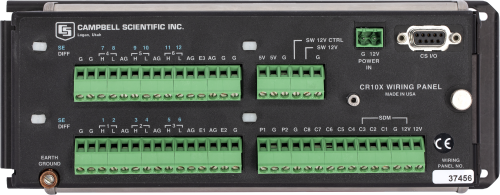This product is no longer available and has been replaced by: CR1000X. Some accessories, replacement parts, or services may still be available.

| Services Available | |
|---|---|
| Repair | No |
| Calibration | Yes |
| Free Support | No |
Overview
The CR10X provided sensor measurement, timekeeping, data reduction, data/program storage and control functions. The CR10X stored up to 62,000 data points. Data and programs were stored either in a nonvolatile Flash memory or RAM. A lithium battery backed up the RAM and real-time clock. The CR10X also suspended execution when primary power (BPALK, PS100) dropped below 9.6 V, reducing the possibility of inaccurate measurements.
Read MoreBenefits and Features
- Designed for unattended network applications
- Stores 62,000 data points (nonvolatile)
- Data format options are mixed array (default) or table
- Detachable keyboard/display, the CR10KD, can be carried to multiple stations
Images

Technical Description
The data logger consisted of a CR10XM Measurement and Control Module and black CR10X Wiring Panel.
The CR10X provided sensor measurement, timekeeping, data reduction, data/program storage and control functions. The CR10X stored up to 62,000 data points. Data and programs were stored either in a nonvolatile Flash memory or RAM. A lithium battery backed up the RAM and real-time clock. The CR10X also suspended execution when primary power (BPALK, PS100) dropped below 9.6 V, reducing the possibility of inaccurate measurements.
Compatibility
A typical field-based CR10X system included:
- CR10X Measurement and Control Module and Wiring Panel with specified Operating System
- Alkaline or Sealed Rechargeable Power Supply
- Weatherproof Enclosure
- Communications Peripheral(s)
- Programming and Communications Software
- Sensors
Specifications
- Memory: up to 62,000 data points
- Analog inputs: 12 single-ended or 6 differential, individually configured
- Pulse counters: 2
- Switched voltage excitations: 3
- Control/digital ports: 8
- Serial I/O port: 1
- Scan rate: 64 Hz
- Burst mode: 750 Hz
- Analog volt. resolution: to 0.33 µV
- A/D bits: 13
- Programming: Edlog
- Data Storage: Mixed Array, Table
- Telecommunications: PakBus, Modbus, Alert
Related Documents
Downloads
CR10X OS v.1.23 (1.45 MB) 02-04-2010
Execution of this download installs the CR10X Operating System (Mixed-Array) on your computer.
Note: The Device Configuration Utility is used to upload the included operating system to the datalogger. Requires an SC32A or SC32B.
CR10X-TD OS v.1.15 (645 KB) 28-03-2006
Execution of this download installs the CR10X Table Data Operating System on your computer.
Note: The Device Configuration Utility is used to upload the included operating system to the datalogger. Requires an SC32A or SC32B.
CR10X-PB OS v.1.10 (647 KB) 28-03-2006
Execution of this download installs the CR10X PakBus Operating System on your computer.
Note: The Device Configuration Utility is used to upload the included operating system to the datalogger. Requires an SC32A or SC32B.
Device Configuration Utility v.2.32.01 (47.7 MB) 15-04-2025
A software utility used to download operating systems and set up Campbell Scientific hardware. Also will update PakBus Graph and the Network Planner if they have been installed previously by another Campbell Scientific software package.
Supported Operating Systems:
Windows 11 or 10 (Both 32 and 64 bit)
Related FAQs
Number of FAQs related to CR10X: 12
Expand AllCollapse All
Case Studies
Chevron Mining, Inc., (CMI) owned and operated a 6.6 million-metric-ton-per-year (6.6 million-U.S.-ton) molybdenum mining and......read more
In 1922, when the tomb of Tutankhamen was discovered in Egypt's Valley of the Kings,......read more
South Africa's subtropical climate is favorable for citrus fruit production. South Africa annually exports roughly......read more
The North County Transit District (NCTD) of San Diego County, California, determined that three segments......read more
Competition for limited water resources in the western United States is increasing, as are the......read more
Forests in the Blue Ridge region are undergoing numerous changes due to: Change in land......read more
Imagine the bored mind of a space traveler as he looks around the room he......read more
Campbell Scientific recently supplied agrometeorological stations for an important research project in Costa Rica. The......read more




